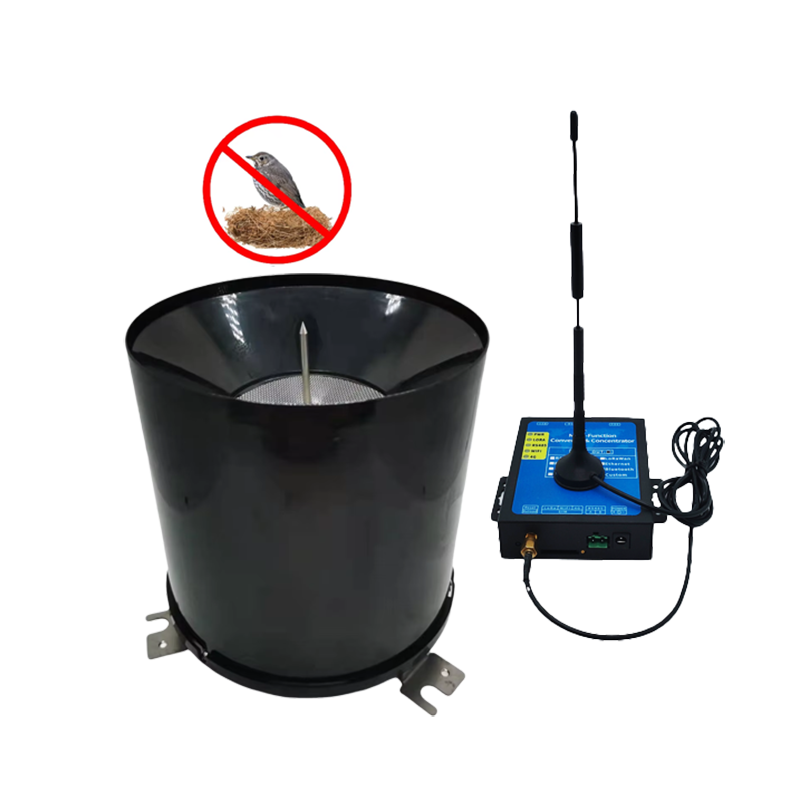ရက်စွဲ- ဇန်နဝါရီ ၂၁၊ ၂၀၂၅
အလယ်ပိုင်းနှင့် တောင်အမေရိကတစ်လျှောက် ပြန့်ကျဲနေသော တက်ကြွသောမြို့များတွင် မိုးရွာခြင်းသည် ရာသီဥတုဖြစ်စဉ်တစ်ခုမျှသာဖြစ်သည်။ သန်းပေါင်းများစွာ၏အသက်တာကို ပုံသွင်းပေးသည့် အားကောင်းသည့် စွမ်းအားတစ်ခုဖြစ်သည်။ ကိုလံဘီယာနိုင်ငံ၊ ဘိုဂိုတာ၏ လူစည်ကားသောလမ်းများမှသည် ချီလီနိုင်ငံ၊ Valparaíso ၏ လှပသောလမ်းများအထိ၊ မြို့ကြီးများသည် ရာသီဥတုဖောက်ပြန်မှု၊ မြို့ပြရေလျှံမှုနှင့် ရေရှားပါးမှုနှင့် ရေရှားပါးမှုဆိုင်ရာ စိန်ခေါ်မှုများနှင့် ရင်ဆိုင်နေရသောကြောင့် ရေအရင်းအမြစ်များကို ထိရောက်စွာ စီမံခန့်ခွဲခြင်းသည် ပို၍အရေးကြီးလာသည်။
မကြာသေးမီနှစ်များအတွင်း၊ ခေါင်မိုးများ၊ ပန်းခြံများနှင့် အများသူငှာရင်ပြင်များတွင် မိုးရေချိန်တိုင်းကိရိယာ အာရုံခံကိရိယာများ ဆန်းသစ်တီထွင်မှုတစ်ခု စတင်ပေါ်ပေါက်လာခဲ့သည်။ မိုးရေချိန်ကို အချိန်နှင့်တပြေးညီ တိကျစွာတိုင်းတာပေးသည့် အဆိုပါစမတ်ကိရိယာများသည် ပိုမိုကောင်းမွန်သော မြို့ပြစီမံကိန်းရေးဆွဲခြင်း၊ တုံ့ပြန်မှုရှိသော အခြေခံအဆောက်အအုံများနှင့် ရပ်ရွာခံနိုင်ရည်ကို မြှင့်တင်ပေးခြင်းတို့အတွက် လမ်းခင်းပေးပါသည်။
နည်းပညာသို့ ကူးပြောင်းခြင်း- မိုးရေချိန်တိုင်းကိရိယာများ မြင့်တက်လာမှု
ယခင်က မြို့ပြစီမံကိန်းရေးဆွဲသူများသည် ကြိုကြားကြိုကြားမိုးလေဝသသတင်းများနှင့် မုန်တိုင်းရေကို စီမံခန့်ခွဲရန်နှင့် အရင်းအမြစ်များခွဲဝေရန် ခေတ်နောက်ကျသောနည်းလမ်းများကို မှီခိုအားထားခဲ့ကြသည်။ မိုးရေချိန်တိုင်းကိရိယာများ မိတ်ဆက်ခြင်းသည် ခေတ်မမီတော့သော ပါရာဒိုင်းကို ပြောင်းလဲစေခဲ့သည်။ တိကျသော၊ တည်နေရာအခြေခံ မိုးရွာသွန်းမှုဒေတာကို ပေးဆောင်ခြင်းဖြင့်၊ အဆိုပါအာရုံခံကိရိယာများသည် မြို့ပြအာဏာပိုင်များအား ရေနုတ်မြောင်းစနစ်များ၊ ရေလွှမ်းမိုးမှုကြိုတင်ကာကွယ်ရေးအစီအမံများနှင့် ရေထိန်းသိမ်းမှုဗျူဟာများနှင့်ပတ်သက်၍ အသိပေးဆုံးဖြတ်ချက်များချနိုင်စေမည်ဖြစ်သည်။
မာရီယာနာခရုဇ်Bogotá Metropolitan Planning Institute နှင့် လက်တွဲဆောင်ရွက်နေသော သဘာဝပတ်ဝန်းကျင် အင်ဂျင်နီယာတစ်ဦးမှ "မိုးရွာသွန်းမှု ပြင်းထန်သော ဘိုဂိုတာတွင် ရေကြီးရေလျှံမှုများ ဖြစ်ပေါ်နိုင်သဖြင့် အချိန်နှင့်တပြေးညီ ဒေတာရယူခြင်းသည် ကျွန်ုပ်တို့အား ကြိုတင်ခန့်မှန်းပြီး အရေးပေါ်တုံ့ပြန်ရန် ကူညီပေးပါသည်။ ယခင်က ကျွန်ုပ်တို့သည် လက်ရှိအခြေအနေများကို အမြဲမတွေးတောနိုင်သော သမိုင်းအချက်အလက်များအပေါ် အခြေခံ၍ ဆုံးဖြတ်ချက်များချခဲ့ပါသည်။"
Smart Cities တည်ဆောက်ခြင်း- မြို့ပြစီမံကိန်းတွင် အာရုံခံကိရိယာများ ပေါင်းစပ်ခြင်း။
အလယ်ပိုင်းနှင့် တောင်အမေရိကတစ်ဝှမ်းရှိ မြို့ကြီးများသည် စမတ်မြို့ပြဖြေရှင်းချက်များကို အကောင်အထည်ဖော်ရန်အတွက် Internet of Things (IoT) ၏ စွမ်းအားကို အသုံးချနေကြသည်။ ဆောပေါလို၊ ဘရာဇီးနှင့် ကွီတို၊ အီကွေဒေါကဲ့သို့ မြို့ကြီးများတွင် မိုးရေချိန်တိုင်းကိရိယာ အာရုံခံကိရိယာများ ကွန်ရက်များကို ပိုမိုကျယ်ပြန့်သော စမတ်မြို့အစပျိုးမှုများ၏ တစ်စိတ်တစ်ပိုင်းအဖြစ် အသုံးပြုထားသည်။
ဥပမာ၊ ဆောပေါလိုတွင်၊ မြို့တော်သည် မြို့တော်ဧရိယာတစ်လျှောက် အာရုံခံကိရိယာ ၃၀၀ ကျော်ကို ပေါင်းစပ်ထားသည့် “Smart Rain” ပရောဂျက်ကို စတင်ခဲ့သည်။ ဤအာရုံခံကိရိယာများသည် မြို့တော်အရာရှိများအား မိုးရွာသွန်းမှုပုံစံများကို စောင့်ကြည့်ကာ အချိန်နှင့်တပြေးညီ ရေလွှမ်းမိုးမှုဖြစ်နိုင်ချေကို ကြိုတင်ခန့်မှန်းရန် ကူညီပေးသည့် ဗဟိုချုပ်ကိုင်မှုရှိသော cloud စနစ်သို့ ဒေတာပေးပို့ပါသည်။
ကားလို့စ် မန်ဒက်စ်São Paulo City Government မှ ပရောဂျက်မန်နေဂျာ တစ်ဦးက "စဉ်ဆက်မပြတ် စောင့်ကြည့်ခြင်းဖြင့်၊ ကျွန်ုပ်တို့သည် မြို့၏ မည်သည့်နေရာများတွင် ရေလွှမ်းမိုးမှုအန္တရာယ်နှင့် ကြုံတွေ့နေရသည်ကို ခွဲခြားသိရှိနိုင်ပြီး ဘေးအန္တရာယ်မကျရောက်မီတွင် နေထိုင်သူများကို သတိပေးနိုင်ပါသည်။ ဤနည်းပညာသည် အသက်နှင့် ပိုင်ဆိုင်မှုများကို ကယ်တင်ပါသည်။"
ရပ်ရွာ ထိတွေ့ဆက်ဆံမှု- ဒေသခံပြည်သူများအား စွမ်းဆောင်ရည်မြှင့်တင်ပေးခြင်း
မိုးရေချိန်တိုင်းကိရိယာများ၏ သက်ရောက်မှုသည် မြူနီစပယ်အစိုးရများထက် ကျော်လွန်သည်။ ၎င်းတို့သည် လူမှုအသိုင်းအဝိုင်းများကိုလည်း စွမ်းဆောင်ပေးသည်။ မြို့အများအပြားသည် ဤအာရုံခံကိရိယာများကို တပ်ဆင်ထိန်းသိမ်းရန် ဒေသခံအဖွဲ့အစည်းများနှင့် ပူးပေါင်းကာ နေထိုင်သူများအကြား ပိုင်ဆိုင်မှုကို ဖန်တီးပေးသည်။ ပတ်ဝန်းကျင် စောင့်ကြည့်ရေးတွင် နိုင်ငံသားများ၏ ပါဝင်မှုကို အားပေးခြင်းဖြင့် မြို့များသည် ရာသီဥတုနှင့် ဆက်နွှယ်သော ဘေးအန္တရာယ်များကို ခံနိုင်ရည်ရှိသော ယဉ်ကျေးမှုကို မွေးမြူနိုင်သည်။
ကိုလံဘီယာနိုင်ငံ၊ Medellín တွင် အခြေခံလူတန်းစားများ၏ အစပျိုးမှုဟု လူသိများသည်။“Luvia y Ciudad”(မိုးနှင့်မြို့) သည် ၎င်းတို့၏ရပ်ကွက်များတွင် မိုးရေချိန်တိုင်းကိရိယာများတပ်ဆင်ခြင်းနှင့် စီမံခန့်ခွဲခြင်းတွင် ဒေသခံစေတနာ့ဝန်ထမ်းများပါ၀င်သည်။ ဤပူးပေါင်းဆောင်ရွက်မှုသည် အဖိုးတန်အချက်အလက်များကို ပံ့ပိုးပေးရုံသာမက ရာသီဥတုပြောင်းလဲမှု၊ ရေစီမံခန့်ခွဲမှုနှင့် မြို့ပြရေရှည်တည်တံ့ခိုင်မြဲရေးတို့အကြောင်း ပြောဆိုမှုများလည်း ဖြစ်ပေါ်စေခဲ့သည်။
အယ်လ်ဗာရို ပီရက်ဇ်Medellín ရှိ ရပ်ရွာခေါင်းဆောင်တစ်ဦး က "ရပ်ရွာနှင့် ထိတွေ့ဆက်ဆံခြင်းသည် ရေထိန်းသိမ်းမှုနှင့် ရေရှည်တည်တံ့သော အလေ့အကျင့်များ၏ အရေးပါမှုကို ပိုမိုသိရှိနားလည်စေပါသည်။ လူများသည် ကျဆင်းမှုတိုင်းသည် အရေအတွက်များလာသည်ကို နားလည်လာကြပြီး ၎င်းတို့၏ ပတ်ဝန်းကျင် ကျန်းမာရေးကို အထောက်အကူပြုနိုင်သည်" ဟု မှတ်ချက်ပြုခဲ့သည်။
စိန်ခေါ်မှုများကိုရင်ဆိုင်ပါ - ရှေ့ခရီး
အလားအလာရှိသော တိုးတက်မှုများရှိသော်လည်း မြို့ပြစီမံကိန်းတွင် မိုးရေချိန်တိုင်းကိရိယာများ ပေါင်းစပ်ခြင်းသည် စိန်ခေါ်မှုများမကင်းပါ။ ဒေတာလက်လှမ်းမီနိုင်မှု၊ နည်းပညာတတ်မြောက်မှုနှင့် ပြုပြင်ထိန်းသိမ်းမှုအတွက် ရန်ပုံငွေကဲ့သို့သော ပြဿနာများကို ဤစနစ်များ၏ ရေရှည်ထိရောက်မှုရှိစေရန်အတွက် ကိုင်တွယ်ဖြေရှင်းရမည်ဖြစ်သည်။
ဒါ့အပြင် Data Overload ဖြစ်နိုင်ခြေလည်း ရှိပါတယ်။ များပြားလှသော အချက်အလက်များစွာကို ပံ့ပိုးပေးသည့် အာရုံခံကိရိယာများဖြင့် မြို့ပြစီမံကိန်းရေးဆွဲသူများနှင့် ဆုံးဖြတ်ချက်ချမှတ်သူများသည် ဒေတာကို အဓိပ္ပါယ်ရှိသော နည်းလမ်းများဖြင့် ခွဲခြမ်းစိတ်ဖြာပြီး အသုံးချရန် ထိရောက်သောနည်းလမ်းများကို ဖော်ထုတ်ရမည်ဖြစ်သည်။ တက္ကသိုလ်များ၊ နည်းပညာကုမ္ပဏီများနှင့် ဒေသန္တရအစိုးရများအကြား ပူးပေါင်းဆောင်ရွက်မှုများသည် ထိရောက်သောမူဝါဒနှင့် လုပ်ဆောင်ချက်ကို မောင်းနှင်နိုင်သည့် ဒေတာခွဲခြမ်းစိတ်ဖြာမှုမူဘောင်များတည်ဆောက်ရန်အတွက် မရှိမဖြစ်လိုအပ်ပါသည်။
အနာဂတ်အတွက် မျှော်မှန်းချက်
အလယ်ပိုင်းနှင့် တောင်အမေရိကတစ်ဝှမ်းရှိ မြို့ကြီးများသည် နည်းပညာကို ဆက်လက်လက်ခံလာသောကြောင့် မိုးစက်ကိရိယာများ၏ အခန်းကဏ္ဍသည် ကြီးထွားလာမည်ဖြစ်သည်။ ရာသီဥတုပြောင်းလဲမှုကြောင့် မိုးရွာသွန်းမှုအကြိမ်ရေနှင့် ပြင်းထန်မှု တိုးလာခြင်းကြောင့် အဆိုပါကိရိယာများသည် မြို့ကြီးများကို လိုက်လျောညီထွေဖြစ်ပြီး လျင်မြန်စွာပြောင်းလဲနေသော ပတ်ဝန်းကျင်တွင် ရှင်သန်ကြီးထွားလာစေရန် ကူညီပေးရာတွင် အရေးပါလာမည်ဖြစ်သည်။
နိဂုံးချုပ်အားဖြင့်၊ မိုးရေချိန်တိုင်းကိရိယာများ ပေါင်းစပ်ထည့်သွင်းခြင်းသည် မိုးရွာသွန်းမှုကို တိုင်းတာခြင်းအတွက်သာ မဟုတ်ဘဲ၊ ၎င်းသည် မြို့တော်စီမံကိန်းနှင့် သဘာဝဘေးအန္တရာယ် ကြိုတင်ပြင်ဆင်မှုဆိုင်ရာ ရှေ့ရှုတွေးခေါ်မှုဆိုင်ရာ ချဉ်းကပ်မှုကို ထင်ဟပ်စေပါသည်။ နည်းပညာကို အသုံးချခြင်း၊ လူမှုအသိုင်းအဝိုင်းများ ထိတွေ့ဆက်ဆံခြင်းနှင့် ရေရှည်တည်တံ့မှုကို မြှင့်တင်ခြင်းဖြင့် အလယ်ပိုင်းနှင့် တောင်အမေရိကတစ်ဝှမ်းရှိ မြို့များသည် မုန်တိုင်းဒဏ်ကို ခံနိုင်ရည်ရှိရုံသာမက ၎င်းတို့ကို ထိပ်တိုက်တွေ့ဆုံရန် ပြင်ဆင်နေကြသည်။ မြို့ပြဧရိယာများသည် စမတ်ကျသောမြို့များအဖြစ်သို့ ပြောင်းလဲလာသည်နှင့်အမျှ မိုးစက်များသည် မှန်းလို့မရနိုင်သော တွန်းအားတစ်ခုမဟုတ်တော့ဘဲ ရေရှည်တည်တံ့ခိုင်မြဲသောအနာဂတ်အတွက် ဆုံးဖြတ်ချက်များကို မောင်းနှင်ရန် အရေးကြီးသော အချက်အလက်အချက်တစ်ခုဖြစ်သည်။
ပိုမိုးရေစက်အချက်အလက်၊
ကျေးဇူးပြု၍ Honda Technology Co., LTD ကိုဆက်သွယ်ပါ။
Email: info@hondetech.com
ကုမ္ပဏီဝဘ်ဆိုဒ်- www.hondetechco.com
စာတိုက်အချိန်- Jan-21-2025


